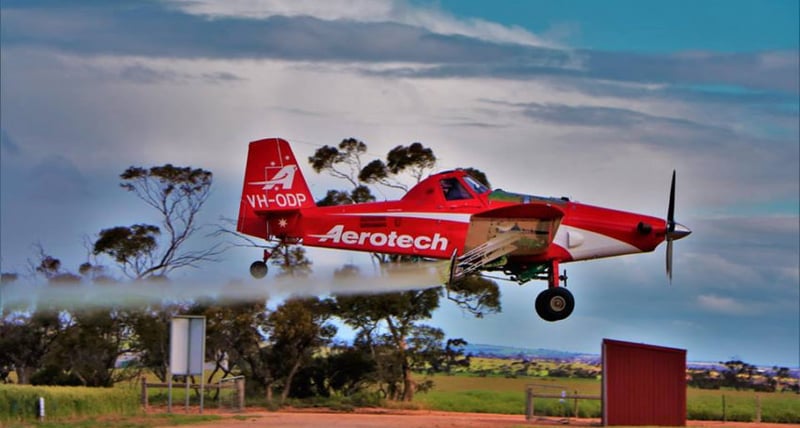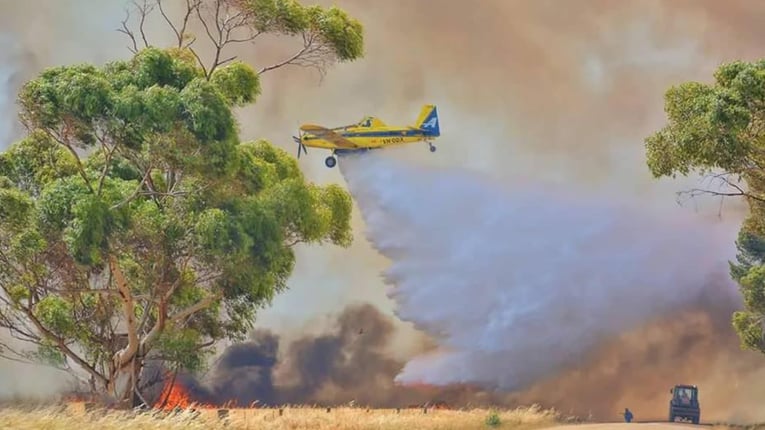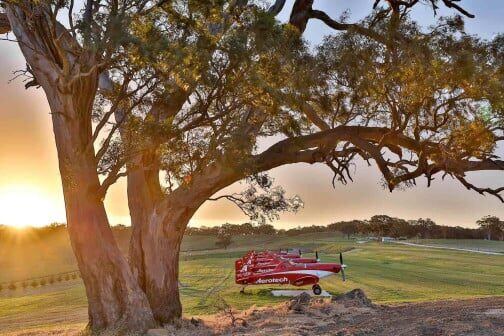- In the Beginning
- Aerial Firefighting Operations in South Australia
- Cutting Edge Technology
- Future Trends
In the Beginning
Sam McCabe, the Managing Director and Chief Pilot, explained the company’s early days. “My father started the business with one agricultural aircraft in Tintinara. As the agricultural side grew over time, Dad started aerial firefighting with a couple of 301s around 30 years ago. Then about 15 years ago we had a couple of 802s for the state, which is when the National Aerial Firefighting Centre (NAFC) came along. There was a pot of money put in the NAFC for the states, with the idea that if any of the states wanted to add to the original amount, the federal government would help, matching them in a 50-50 arrangement.”
Contracts are done on a national tender basis through the NAFC, Sam explained. “They do the procurement pretty much for the whole country now. The NAFC contract right now is for three-plus one plus one (three years, plus two more, potentially, in one-year increments). We’ve just started the second year of our three. They’ve been doing it that way for the past 15 years."
Once the NAFC program began, Aerotech went from two aircraft to six in only one year. It’s slowly grown over the last 15 years to 25 aircraft.
“We also have a couple of fixed-wing aerial platforms, a Cessna Caravan and a Piper Meridian, and four Squirrel (Aerocopter AS350) helicopters for air attack and observation.”
It’s a good-sized operation, and generally, all operations are conducted in South Australia. “We did send one helicopter up to the Northern Territory this year for the first time, where we have won a contract for Air Attack, but it’s a good fit here in South Australia and we generally have 20 machines contracted.”
And it’s a year-round operation.
“Fire season runs here from November until April, then we have a busy time doing ag (spraying) from mid-July through to about October.”

Aerial Firefighting Operations in South Australia
South Australia is divided up into four primary response bushfire zones. The biggest zone is the Adelaide Hills or Mount Lofty Ranges, which is near Adelaide, the state capital, which has eight bombers in it during the peak of the summer. There’s another zone on the Lower Eyre Peninsula, another one in the Lower South East, with its pine forests, and another one in the Mid North, where there are more population and higher risk.
“The aircraft are based at all four locations around the state,” said McCabe.
“We developed a firefighting strategy called Rapid Initial Attack for about 15 years. If a bushfire is reported within a zone, regardless of whether it’s confirmed or not, an aircraft is dispatched. 40% of the time we are turned around and go back to base because there’s no fire, or it’s under control. The first thing that gets going is the aircraft because they can get there quickly. We can’t put the fire out, but we can contain it, keep it small, give the ground assets another 20 minutes to get on site.”
Standing patrols are also utilized. “They’ll send two bombers and two air attack planes to each zone, so we’re on standby every day. As the fire danger increases and it’s a fire ban in that zone, they’ll send four bombers and two [air attack] platforms on any report of a fire.”
But it wasn’t always like this.
“What we found out years ago, back when my father was doing it, was that the agencies were waiting for the fires to get big, so the aircraft wasn’t as effective,” McCabe recalled.
“So, to prove our Rapid Initial Attack strategy was effective, we offered them the first drop for free to prove that early air attack was better.”
It worked so much better that it became standard practice.
“We can reach anyplace in a zone within 15 minutes of being called. When we’re standing by with the aircraft it takes about five minutes to get airborne, plus a 10-minute flight.”
In the more heavily populated areas of the Adelaide Hills, Aerotech keeps a heavy response force at the ready. “We use the three fixed-wing platforms, the Meridian and the Caravan, and four other bombers. If there’s a fire in the rest of the state, they call that the secondary response zone. That means that they have to request aircraft. They’re not automatically dispatched because it’s low risk. Only when the Region requests the planes are they sent out.”
Most of Aerotech’s pilots are local and fly year-round, switching back and forth between aerial spraying and firefighting. They live in the same zone they patrol, so it really works out well for both the pilots and Aerotech. “We do bring some pilots in if we’re really busy,” McCabe pointed out. “About 70% of our pilots fly for us year-round.”
Although the majority of the fires are fought by Aerotech’s AT802s, there’s also an Erickson Air Crane operated by Kestrel that can be called on in a pinch. “No big air-tankers are fighting the fires, just the Crane and the 802s,” McCabe explained.
Cutting Edge Technology
All of Aerotech’s AT-802Fs are equipped with the Trotter Gen II Fire Doors, which allows pilots to choose the coverage level and amount of load to be dropped, enabling pinpoint accuracy.
And as part of their contractual agreement with the NAFC, they are installing Trotter’s latest technology, the DataVault, into their 11 contracted AT-802Fs, enabling real-time reporting back to the Country Fire Service and Aerotech on engine start and stop, take off, landing, load and coverage levels.
“All the fixed-wing platforms and the helicopters utilize TracPlus, which works really well,” said McCabe. “We’ve been really happy with the TracPlus equipment.”

Future Trends
“I’m not sure what’s next,” McCabe confessed. “In the air-tanker world, there’s the AT-1002 coming, which has been coming for a long time. We have a 710 Thrush we bought two years ago. We put a Transland fire door on it and we’re comparing it with the 802. It’s a capable machine, and it’s certainly an option. It has 10% less capacity, so it’s not as useful a load as an 802, but it’s very fast, quicker than an 802. For now, Air Tractor is pretty much it.”
Aerotech is investing in new technology to aid observation as well. “The CM160 camera, manufactured by Australian Company UAV Vision, will add value and sophistication to our existing service,” McCabe said proudly. “It’s part of our continued effort for improvement. We see it as a cost-effective way of delivering real-time data streaming for clients. It can also be fitted to our fixed-wing aircraft for longer-range applications.”
A new source of aircraft is also being made available.
“There seems to be a push towards military aircraft for firefighting. We will see five or six Blackhawks coming to Australia this summer. They will be modified to carry tanks like a Firehawk for built-up areas because they don’t allow buckets over those areas,” McCabe summarized.
“We’ll look at NVG in the future. Our helicopter team has done a bit of inquiry into that. We haven’t done any pilot training as of yet. It would probably be more on the observation side than on the bombing side. When we got the quote on outfitting the helicopter cockpits and doing the training, just to get up and running, it was about $100,000.”
A pricey innovation at that, but with so many other contractors in Australia and abroad venturing into nighttime operations, NVG may be another wave of the future for Aerotech.
Our equipment could work perfectly for your company, just as it did for Aerotech. If you'd like to find out more contact us or demo TracPlus now.
